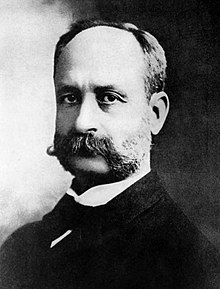This article needs additional citations for verification. (February 2011) |
Rafael Guastavino | |
|---|---|
 Portrait of Rafael Guastavino | |
| Born | Rafael Guastavino Moreno March 1, 1842 |
| Died | February 1, 1908 (aged 65) |
| Resting place | Basilica of St. Lawrence, Asheville |
| Engineering career | |
| Discipline | Architectural engineering |
| Significant advance | Guastavino tile |
Rafael Guastavino Moreno (Spanish pronunciation: [rafaˈel ɣwastaˈβino]; March 1, 1842 – February 1, 1908) was a Spanish building engineer and builder who immigrated to the United States in 1881; his career for the next three decades was based in New York City.[1]
Based on the Catalan vault, he created the Guastavino tile, a "Tile Arch System", patented in the United States in 1885, which was used for constructing robust, self-supporting arches and architectural vaults using interlocking terracotta tiles and layers of mortar. His work appears in numerous prominent projects designed by major architectural firms in New York and other cities of the Northeast. Guastavino tile is found in some of New York's most prominent Beaux-Arts landmarks and in major buildings across the United States. It is also used in numerous architecturally important and famous buildings with vaulted spaces.
- ^ "9 Dazzling Tiled Archways Devised by Rafael Guastavino | Architectural Digest". Architectural Digest. Retrieved 2017-09-20.